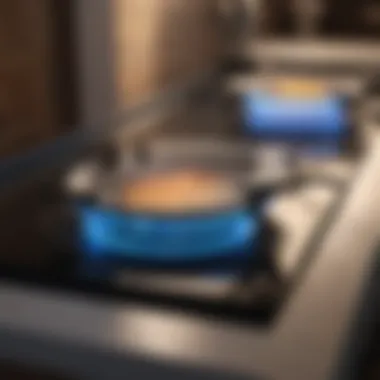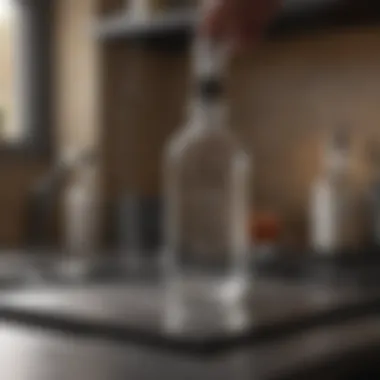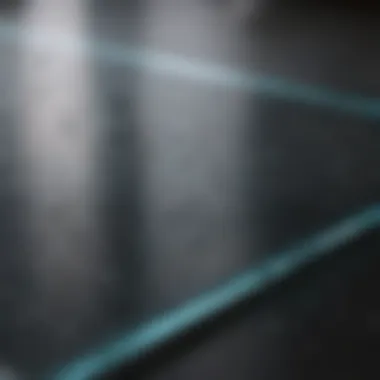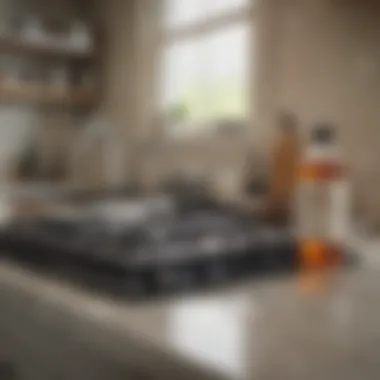Cleaning Glass Stove Tops: Vinegar Techniques


Intro
Cleaning glass stove tops can sometimes feel like a chore, but it doesn’t have to be a laborious task. Utilizing a simple household item—vinegar—makes this endeavor both effective and eco-friendly. The beauty of vinegar is not just in its cleaning prowess but also in its versatility. Unlike harsh chemical cleaners that pose risks to health and the environment, vinegar offers a natural solution that can leave your cooking surface sparkling clean and safe for food preparation.
In this article, we will thoroughly explore the art of cleaning glass stove tops using vinegar. It’s not just about wiping down a surface; it’s an approach rooted in sustainability and practicality. Homeowners will learn various techniques, understand the importance of safety when using cleaning solutions, and gather maintenance tips that promote longevity for their stove tops.
The connection between maintaining a kitchen and preserving health is vital. A clean stove top can lead to a healthier cooking environment. With the insights provided here, readers will be equipped to not only achieve cleanliness but also to foster an appreciation for an eco-friendly lifestyle amid their routine chores.
Understanding Glass Stove Tops
Understanding glass stove tops is key for anyone who wants to maintain a sparkling clean kitchen. These surfaces are not just a pretty face; they play a crucial role in cooking efficiency and overall kitchen aesthetics. The popularity of glass stove tops has surged recently, as they provide a sleek and modern look, allowing homeowners to elevate their kitchen's ambience. However, keeping them clean can be a bit tricky, and knowing how to tackle it is essential.
Material Composition of Glass Stove Tops
Glass stove tops are typically made from a specific type of glass known as tempered glass. This material is designed to withstand high heat and thermal shock, ensuring that it can cope with the demands of cooking. The tempered glass is usually paired with ceramic components to provide durability and help distribute heat evenly. This combination of materials not only supports effective cooking but also enables the smooth surface that is easy to clean.
Nonetheless, the very quality that makes glass stove tops so desirable can also be a source of vulnerability. For one, surface scratches can occur easily if rough cookware is used. Moreover, the glass can stain or discolor if burnt-on food is left unattended. Understanding these risks is vital, as it aids in employing the right cleaning methods and preventive care to keep your glass stove top looking pristine.
Common Challenges in Cleaning Glass Surfaces
Cleaning glass stove tops comes with its own set of challenges. Here are some common issues one might face:
- Stubborn stains: Food spills can turn into stubborn marks if not dealt with promptly.
- Scratching: Certain cleaning pads or sponges can scratch the glass surface, leading to unsightly scuffs.
- Residue build-up: Over time, grease and cooking residue can accumulate, making it hard to achieve a spotless finish without the right techniques.
It’s also worth noting that many standard cleaners can be too harsh or abrasive for glass surfaces. They may leave a cloudy film or even damage the material, which can be a costly blunder. Being aware of these challenges is indispensable for anyone using glass stove tops, as it prepares you to engage in proactive care and effective cleaning strategies.
"A good job isn't just done; it's done well. Knowing your tools is half the battle."
Vinegar as a Cleaning Agent
Vinegar isn’t just something you splash on your salad; it’s a powerhouse for cleaning, especially for glass stove tops. This section will dive into the specific elements that make vinegar a preferred cleaning agent, the unique benefits it offers compared to harsher chemicals, and some important considerations to keep in mind.
Chemical Properties of Vinegar
Vinegar is primarily made of acetic acid, which comes from the fermentation of ethanol. This might sound simple, but those two ingredients do a lot of heavy lifting when it comes to lifting grime.
The acidity in vinegar breaks down tough deposits that accumulate on glass surfaces, like food splatters and grease. This property is why it’s often touted as a great natural degreaser. Not to mention, it has a pH level around 2-3, which makes it a natural disinfectant as well, killing off certain types of bacteria. So, it’s not just for looks; it’s also about keeping your cooking surface healthy and hygienic.
Benefits of Using Vinegar for Cleaning
Using vinegar for cleaning glass stove tops offers multiple advantages that you might not find in chemical-laden products. Here are some key benefits:


- Eco-Friendly: Vinegar is non-toxic and biodegradable, making it an environmentally conscious choice. When you spray vinegar, you’re not releasing fumes that could make you choke or cause irritation.
- Cost-Effective: A bottle of vinegar costs only a couple of bucks, so you can save your pennies for the next home improvement project. In contrast, commercial cleaners can usually drain your wallet with just a few squirts.
- Versatile: Whether you’re tackling grime on the stove top or need a solution for cleaning windows, vinegar can be a jack-of-all-trades in your cleaning arsenal. Its multi-purpose capabilities means you don’t need to clutter your cupboards with various cleaners.
- Streak-Free Shine: After utilizing vinegar, your glass stove top won’t just be clean; it can shine like new. This is particularly important for the aesthetics of your kitchen.
- Easy to Use: Cleaning with vinegar does not require advanced skills. You just mix it with some water, spray, and wipe away. Simple as pie.
"Cleaning doesn’t have to be complicated. Vinegar is a straightforward and effective solution to common kitchen messes."
In summary, vinegar is an effective cleaning agent for glass stove tops due to its unique composition. Its benefits stretch beyond just cleaning—it offers a wallet-friendly, eco-sensitive approach to maintaining your kitchen surfaces. By opting for vinegar, you’re choosing an efficient solution that doesn’t compromise your health or the planet.
Preparing the Stove Top for Cleaning
Cleaning a glass stove top might seem like a simple task, but without the proper preparation, you could be setting yourself up for frustration. Taking the time to prepare sets a solid foundation for the cleaning process, ensures you’re equipped and informed, and prevents any unnecessary damage to your stove.
When cleaning glass surfaces, like a stove top, it’s essential to address certain elements beforehand. Here’s why preparation is crucial:
- Avoiding Scratches: If you don’t clear the surface properly or use the wrong tools, you could scratch the glass.
- Identifying Stains: Before you start scrubbing, inspect for grease or burnt residue, which could require special attention.
- Organizing Supplies: Gathering your cleaning supplies beforehand will save you from running around mid-cleaning, which can distract you and diminish the quality of your work.
Gathering Necessary Cleaning Supplies
Gathering the right cleaning supplies is like assembling a toolkit — each item plays a role in achieving that spotless shine. For cleaning glass stove tops with vinegar, you will need:
- White Vinegar: This is your primary cleaning agent. Its acidity cuts through grime.
- Baking Soda: Perfect for tackling stubborn stains, it works well alongside vinegars as a gentle abrasive.
- Microfiber Cloths: These trap dirt without scratching the surface, making them indispensable.
- Spray Bottle: Ideal for mixing and storing your vinegar solution.
- Scraper: A plastic or silicone scraper can help lift off caked food remnants without scratching.
- Warm Water: Not to be overlooked, it's necessary for rinsing away cleaning agents.
Having these supplies ready ensures that when you’re in cleaning mode, you can stay efficient and focused.
Safety Precautions to Consider
Before diving headfirst into cleaning your glass stove top, taking a moment to consider safety precautions can save you a world of trouble. Here are some vital tips:
- Warm Surface: Always allow the stove to cool down completely. Working on a hot surface is a recipe for burns and accidents.
- Use Gloves: If you have sensitive skin or are working with more potent mixtures, gloves can help protect your hands.
- Ventilation: Make sure the area is well-ventilated, especially since some cleaning products can have strong odors. Opening windows or using an exhaust fan is a simple way to keep the air fresh.
- Keep Children and Pets Away: During the cleaning process, it’s wise to have kids and pets in a different area, ensuring everyone’s safety.
"Preparation may feel like a hassle, but a few moments spent organizing and considering safety can prevent long-term issues."
By prioritizing these preparations and precautions, you’ll enter the cleaning phase equipped and ready for whatever challenges your glass stove top may throw at you.
Step-by-Step Cleaning Process
The step-by-step cleaning process of glass stove tops using vinegar stands as a practical approach, providing clarity and efficiency. Glass stove tops, while visually appealing, can quickly become the bane of any cook�’s existence due to spills, splatters, and food residue. A systematic method not only ensures thorough cleaning but also preserves the delicate surface of the stove. When done correctly, these techniques can amplify the aesthetic of your kitchen while extending the lifespan of your appliance.
Initial Wipe Down
Before diving into more intensive cleaning, the initial wipe down serves an essential role. This stage helps remove loose debris and larger particles of food that have accumulated on the stove top. A damp microfiber cloth or paper towel is typically all that’s needed here.
- Importance: This process allows the vinegar to work more effectively later on as it won’t be challenged by the heavier grime. Plus, it prevents scratches that might occur if you start scrubbing without removing the surface dirt.
- Method: Simply wet your cloth, wring it out so it’s not dripping, and gently wipe the surface. Focus on spots where you see food residue. Remember to swap out that cloth if it gets too dirty to avoid dragging dirt across the glass.


Applying Vinegar Solution
Applying the vinegar solution is where the magic truly happens. Vinegar’s acidity cuts through grease and grime with remarkable efficiency. You can create a simple cleaning solution by mixing equal parts of water and white vinegar in a spray bottle.
- Application: Spray the solution generously across the stove top, ensuring it’s evenly coated. Let it sit for about 5-10 minutes. This resting time allows the vinegar to penetrate and loosen the dirt, making it easier to wipe away.
"Patience is key; rushing through this step can often lead to more scrubbing later on."
Using Baking Soda for Stubborn Stains
Now, if you find yourself face-to-face with stubborn stains that refuse to budge, baking soda is your knight in shining armor. This abrasive yet gentle powder works wonders on those tough spots without scratching your glass surface.
- How to Use: After the vinegar has done its bit, sprinkle a light layer of baking soda over the stains. Follow with another spray of the vinegar solution. The mixture will begin to fizz and bubble. While this may look like a science experiment, it’s precisely the reaction you need. Let it sit for about 10 minutes, which allows the fizz to break down any remaining grime effectively.
Final Rinse and Polish
Completing your cleaning journey, the final rinse and polish stage is crucial. After all the scrubbing and applying of solutions, the last thing you want is a residue left behind.
- Rinse: Once you’ve scrubbed with the baking soda, take a clean, damp cloth and wipe down the surface to remove all cleaning agents. You may need to rinse the cloth several times to ensure that no solution remains.
- Polish for Shine: After rinsing, a dry cloth or paper towel should be used to polish the surface, bringing out a sparkling shine. If done right, your glass stove top will not only look like new but will also provide a better cooking experience with no lingering odors.
Balancing methods of cleaning with consideration of your stove's integrity goes a long way in achieving and maintaining an immaculate cooking environment. By following these steps, any homeowner can tackle the common nuisances of glass stove tops effortlessly.
Post-Cleaning Care for Glass Stove Tops
Taking care of your glass stove top after a thorough cleaning is just as crucial as the cleaning process itself. When you’ve put in the effort to scrub away stubborn stains and restore that smooth sheen, it’s important to maintain that cleanliness to ensure the durability of the surface and enhance the cooking experience. Post-cleaning care centers around keeping your stove top looking pristine while also preserving its functionality.
Routine Maintenance Practices
Routine maintenance can prevent dirt and grime from accumulating, which saves you from stepping into a cleaning marathon later. Here are some practices to consider:
- Wipe Down After Use: After every meal, take a moment to wipe down the stove top with a damp cloth. This will rid the surface of spills before they dry and become difficult to remove.
- Use Soft Cloths: If you prefer a bit more shine, use a microfiber cloth to buff the surface gently. Microfiber is excellent for picking up dirt without scratching.
- Keep an Eye on the Burners: Stains from pans can jump to the burners and back onto the glass. Regularly check these areas and clean them as necessary.
- Use a Vinegar Mist: A weak vinegar solution in a spray bottle can work wonders, lightly misting the stove top to disinfect while enhancing the shine without presumable residue.
Incorporating these little habits means you won’t need to go to battle with grime as often.
Preventing Future Stains and Buildup
Preventing future stains is about adjusting how you use and care for your stove. Here’s how to avoid the headache of stubborn buildup:
- Avoid Cooking Sprays: Many sprays contain oils that can gum up your stove top. Consider using foil or oven-safe dishes to reduce excess grease.
- Cover Your Pots: When cooking, lids can help contain splatters. This isn’t just a nifty trick, it also aids in moisture retention for perfectly cooked meals.
- Choose Cookware Wisely: Using flat-bottomed pans can be a game changer. They distribute heat evenly and are less likely to scratch your glass surface.
- Prompt Action: If something spills, tackle it immediately. Letting it sit can lead to burnt-on stains that take a good deal of elbow grease to remove.
"A stitch in time saves nine" could not be more applicable here.


By adopting these preventive measures, you not only maintain the aesthetic appeal of your glass stove top but also prolong its lifespan, making your cooking environment more enjoyable and efficient.
Comparative Analysis with Other Cleaning Products
When it comes to keeping glass stove tops gleaming, a variety of cleaning products are available on the market. However, understanding how vinegar stacks up against these options is essential for every household. Not only does this analysis shine a light on the effectiveness and safety of vinegar as a cleaning agent, but it also underscores the broader implications of choosing eco-friendly cleaning methods. Homeowners increasingly seek solutions that are not only effective but also less harmful to the environment. This section dives into both the upsides and downsides of using vinegar compared to its commercial counterparts.
Advantages of Vinegar Over Commercial Cleaners
One of the most compelling reasons to opt for vinegar over commercial cleaners is the unique chemistry that makes it such a powerful cleaning agent. Here are several advantages:
- Eco-Friendly: Vinegar is biodegradable and contains no harsh chemicals. It poses little risk to both family members and pets compared to traditional cleaners that might expose you to toxic fumes.
- Cost-Effective: A bottle of vinegar is considerably cheaper than several gallons of specialized commercial cleaning products designed for glass surfaces. This cost efficiency doesn't come at the expense of performance.
- Versatility: Besides cleaning glass stove tops, vinegar can be used for a myriad of household chores from disinfecting to stain removal. Its multifunctionality means you can do more with one product.
- Effectiveness Against Grime: Vinegar’s acidic properties cut through grease and food residue like a hot knife through butter. Many commercial cleaners merely mask odors or stains without thoroughly breaking them down.
"Vinegar can clear away grime faster than a swoosh of a fancy bottle, leaving you with that crisp and clean finish."
Despite these noteworthy advantages, it's essential to recognize there are also some drawbacks.
Disadvantages to Consider
While vinegar is a standout performer in many areas, it is not without limitations. Some points to be aware of include:
- Odor: The strong smell of vinegar can be off-putting to some. Though it dissipates quickly, the initial scent may not be appealing, especially when cleaning larger surfaces.
- Effectiveness on Tough Stains: While vinegar works wonders on day-to-day messes, particularly stubborn stains or burnt-on food might need a little more elbow grease or the addition of other cleaning agents to assist.
- Potential Surface Damage: For certain types of glass or finishes, the acidity of vinegar could potentially cause wear if used excessively. Always make sure to test a small, inconspicuous area before applying it broadly.
Weighing these factors, vinegar presents a compelling case as a cleaning agent, particularly for individuals looking to simplify their cleaning routine while being mindful of the planet. By choosing vinegar over commercial cleaners, one can enhance their cleaning regimen without compromising on safety or effectiveness.
Ending: The Value of Eco-Friendly Cleaning
Cleaning with vinegar not only gives you a sparkling glass stove top; it's also about embracing greener habits that can have long-lasting effects on our planet. Eco-friendly cleaning practices, like those highlighted in this article, pave the way for a healthier cooking environment while reducing the dependence on harsh chemicals that might linger on surfaces and in the air long after cleaning.
Vinegar, a staple in many kitchens, is much more than just a salad dressing ingredient. Its natural acidity makes it a formidable foe against grease and grime without overwhelming your space with artificial fragrances or toxic compounds. This article has shown how vinegar can be a strategic choice, making it a top contender among cleaning agents. It reflects an encouraging shift towards sustainability that not only caters to immediate cleaning needs but positively impacts our daily lives.
Recap of Cleaning Methodology
To refresh your memory, let’s break down the steps discussed:
- Initial Wipe Down: Remove any loose particles or debris, preparing the surface for a deeper clean.
- Applying Vinegar Solution: Spray a mixture of vinegar and water; allow it to penetrate stubborn stains.
- Using Baking Soda: For those particularly nasty marks, a sprinkle of baking soda creates a fizzy reaction that loosens tough dirt.
- Final Rinse and Polish: Complete the process with a thorough rinse and buff to restore the shine.
This methodology not only sorts out the grime but emphasizes the ease and effectiveness of using what’s already in your pantry.
Encouragement for Sustainable Practices
Integrating sustainable practices into your cleaning regime is easier than it seems. Start with simple steps, like swapping out commercially made cleaners for homemade vinegar solutions. Consider the impact on both your health and the environment. Here are a few suggestions to take it further:
- Explore eco-friendly products: Not all products labeled as ‘green’ are created equal. Always check the ingredients.
- Recycle empty bottles: Instead of throwing away the spray bottle once empty, repurpose it for your homemade cleaning solutions.
- Reduce waste: Whenever possible, use washable cloths instead of paper towels to clean glass surfaces.
By fostering these green habits, you not only sustain your glass stove top's integrity but also contribute to the greater good. It’s a win-win situation, offering practical results in your home while treading lightly on our precious earth.
"The road to a cleaner home begins with sustainable choices. Every little bit counts in making a difference."







